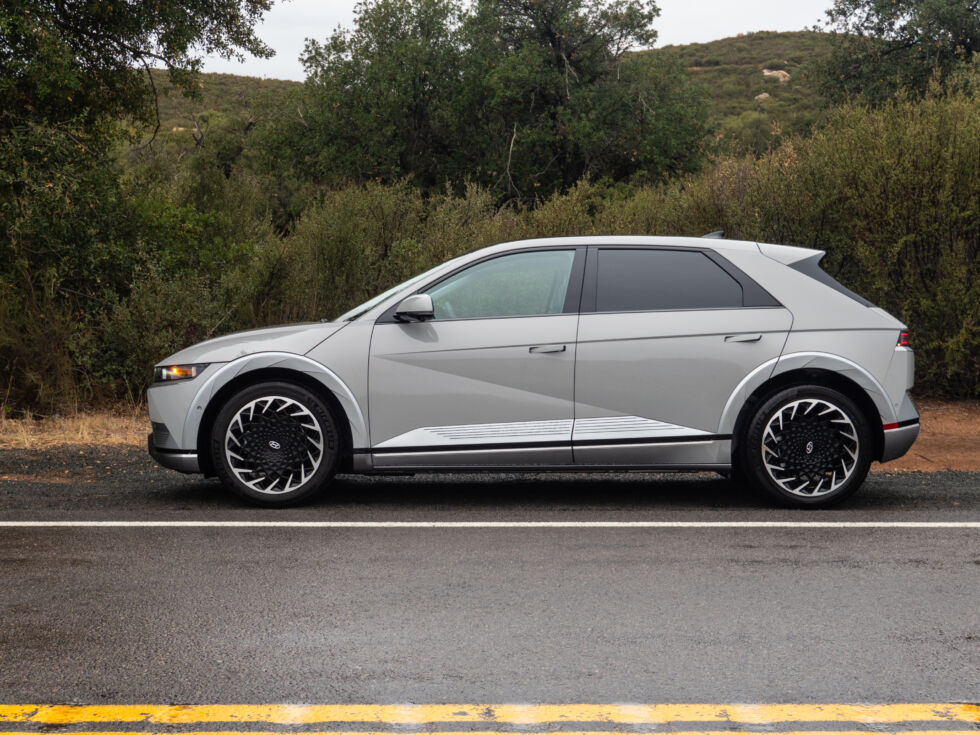The Hyundai Ioniq 5 is the best EV we drove in 2021

SAN DIEGO—In 2020, Hyundai Motor Group revealed that it had developed a new platform built solely for battery electric vehicles. The company’s smaller, earlier EVs have gotten impressively close to Tesla levels of powertrain efficiency, and these days, the Korean automaker is at the head of the class in terms of quality and reliability.
So the excitement was palpable when we learned that this new “Electric-Global Modular Platform” (or E-GMP) was intended for larger, more powerful EVs with either rear- or all-wheel drive. The platform would use an 800 V electrical architecture and would provide 18-minute fast-charging and the ability to power AC devices. The anticipation only grew when we got our first look at the Hyundai Ioniq 5—the first of those EVs—back in February.
In fact, if I had been paying more attention at the 2019 Frankfurt Auto Show, I would have seen the Ioniq 5, barely disguised as a concept called the “45.” The design team, led by SangYup Lee, channeled some of Giorgetto Giugiaro’s angular and boxy energy into the Ioniq 5’s proportions. The 45 concept was meant to pay homage to a 1974 concept that Giugiaro created for the Korean brand, but to my eyes, it’s more reminiscent of a 1980s Lancia Delta, except scaled up by 19 percent.

The sharp looks and spot-on proportions flatter the Ioniq 5. This is no small hatchback—Hyundai classifies the car as a compact SUV. That’s sure to spark some arguments about pigeonholing, but the car is 182.5 inches (4,636 mm) long, 74.4 inches (1,890 mm) wide, and 63 inches (1,600 mm) tall. So it’s much bigger than something like a Volkswagen Golf, but it’s just smaller than a Tesla Model Y. Curb weight varies from 4,200–4,662 lbs (1,905-2,115 kg) depending on the powertrain and trim.
But the Ioniq 5 has a remarkably long wheelbase: 118.1 inches (3,000 mm). That’s longer than the wheelbase on the Tesla or a Porsche Taycan. It’s even longer than the one on Hyundai’s much bigger three-row Palisade SUV. And that translates to a spacious and airy interior for both front and rear occupants.
The interior has a completely flat floor and uses a bunch of recycled materials—old plastic bottles have gone into the armrests and seats, bioplastic from sugarcane contributes to the headlining and carpets, recycled Tyvek fibers show up in trim panels, and the dashboard and door-panel paint uses polyurethane derived from bean oil.

The center console can slide back and forth, and the rear bench seat also slides and reclines. With the back seats in use, there’s 27.2 cubic feet (770 L) of cargo space in the rear, increasing to 59.3 cubic feet (1,671 L) when the rear seats are folded flat. Under the hood is another 0.9 cubic feet (24 L) of storage, but the space is so shallow that we question its utility.
The vehicle-to-load function is accessed via a three-pin AC socket in the cabin (in Limited trim) or by connecting a V2L dongle to the car’s charging port. The system supplies up to 1.9 kW of 120 V AC power and can even be used to slow-charge another EV.
https://arstechnica.com/?p=1821361